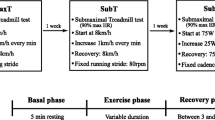Abstract
A comparative study was performed to analyze the diagnostic efficiency of a proposed cardiorespiratory coefficient (CRC) for assessment of dynamic changes in autonomic homeostasis. In the two series of the study, 45 healthy male volunteers were examined using models of emotional tension and acute graded hypoxia. Under stress-inducing conditions, both cardiorespiratory synchronization reflecting the degree of autonomic balance and the changes in the cardiorespiratory system substantially depended on the individual parameters recorded at baseline, specifically, the autonomic tone and the degree of hypoxic resistance. It was found that cardiorespiratory changes could be detected rather quickly during the first minutes of testing if assessed by the CRC changes during test exercises. This allows the accuracy and selectivity of analysis of changes in the integral parameters of autonomic regulation to be increased and the CRC to be recommended as a forecasting criterion for analyzing autonomic homeostasis and autonomic reactivity in humans.
Similar content being viewed by others
References
Sudakov, K.V., Individual’naya ustoichivost’ k emotsional’nomu stressu (Individual Resistance to Emotional Stress), Moscow, 1998.
Baevskii, R.M., Health Level Assessment and Classification in Terms of Adaptation Theory, Vestn. Akad. Med. Nauk SSSR, 1989, no. 9, p. 73.
Zilov, V.G., Methodological Grounds of Health, in Dialektika material’nogo i ideal’nogo v poznanii sushchnosti zdorov’ya i bolezni (Dialectic of Material and Ideal in Understanding the Essence of Health and Disease), Moscow, 1998, p. 32.
Papousek, I., Schulter, G., and Premsberger, E., Dissociated Autonomic Regulation during Stress and Physical Complaints, J. Psychosom. Res., 2002, vol. 52, no. 4, p. 257.
Anokhin, P.K., Ocherki po fiziologii funktsional’nykh sistem (Studies on Physiology of Functional Systems), Moscow, 1975.
Dmitrieva, N.V. and Glazachev, O.S., Individual’noe zdorov’e i poliparametricheskaya diagnostika funktsional’nykh sostoyanii organizma (Individual Health and Polyparametric Diagnostics of the Functional State of the Body), Moscow, 2000.
Baevskii, P.M., Barsukova, Zh.P., and Berseneva, A.P., Otsenka funktsional’nogo sostoyaniya organizma na osnove matematicheskogo analiza serdechnogo ritma: Metodicheskie rekomendatsii (Assessment of the Functional State of the Body on the Basis of Mathematical Analysis of the Heart Rhythm: Methodical Recommendations), Vladivostok, 1998.
Sudakov, K.V. and Glazachev, O.S., Multiple Physiological Assessments of Long-Term Stress at Work and in Daily Life: A System Approach, Advances in Psychosomatic Medicine, Basel: Karger, 2001, vol. 22, p. 61.
Zhemaitite, D.I., Rhythmogram as Reflection of the Specific Features of Regulation of the Heart Rhythm, Ritm serdtsa v norme i patologii (Normal and Pathological Heart Rhythm), Vilnyus, 1970, p. 88.
Stanley, G., Verotta, D., Claft, N., et al., Age and Autonomic Effects on Interrelationships between Lung Volume and Heart Rate, Am. J. Physiol., 1996, vol. 270, no. 5, part 2, p. 1833.
Kotel’nikov, S.A., Nozdrachev, A.D., Kovalenko, A.P., and Odinak, M.M., The Ergotropic Activity Index as an Integral Indicator of the Suprasegmental Centers of Autonomic Regulation, Fiziol. Chel., 2003, vol. 29, no. 3, p. 66.
Hildebrandt, J., Die Coordination Rhitmischer functionen Beimmenschen, Kongr. Inn. Med., 1969, vol. 73, p. 921.
Gus’kov, S.V. and Tarakanov, O.P., Changes in Coordination of Somatoautonomic Rhythms in Operator during Training, Zh. Vyssh. Nervn. Deyat., 1992, vol. 42, iss. 1, p. 21.
Sudakov, K.V., Yumatov, E.A., and Tarakanov, O.P., Cross-Correleation Autonomic Criterion of Emotional Stress, Fiziol. Chel., 1995, vol. 21, no. 3, p. 87.
Hughes, J.W. and Stoney, C.M., Depressed Mood Is Related to High-Frequency Heart Rate Variability during Stressors, Psychosom. Med., 2000, vol. 62, no. 6, p. 796.
Kotel’nikov, S.A., Nozdrachev, A.D., Odinak, M.M., et al., Heart Rate Variability: Overview of Mechanisms, Fiziol. Chel., 2002, vol. 28, no. 1, p. 130.
Dudnik, E.N., Analysis of Cardiorespiratory Interaction as a Criterion of Assessment of Body Functions, Extended Abstract of Cand. Sci. (Biol.) Dissertation, Moscow, 2002.
Pokrovskii, V.M. and Bobrova, M.A., Spike Activity of Neurons of the Medulla Oblongata Associated with Cardiac and Respiratory Rhythms, Fiziol. Zh., 1986, vol. 32, no. 1, p. 98.
Belyaev, K.P. and Kuz’minykh, N.Yu., Methods for Determining Breathing Pattern Based on Parameters Measured with Hemodynamic Monitoring Systems, Biomed. Radioelektr., 1999, no. 3, p. 33.
Reid, M.C., Lachs, M.S., and Feinstein, A.R., Use of Methodological Standards in Diagnostic Test Research. Getting Better but Still Not Good, JAMA, 1995, vol. 274, p. 645.
Ryabykina, G.V. and Soboleva, A.V., Variabel’nost’ serdechnogo ritma (Heart Rate Variability), Moscow, 1998.
Mikhailov, V.M., Variabel’nost’ serdechnogo ritma (Heart Rate Variability), Ivanovo, 2000, p. 182.
Task Force of the European Society of Cardiology and the North American Society of Pacing and Electrophysiology. Heart Rate Variability. Standards of Measurements, Physiological Interpretation, and Clinical Use, Circulation, 1996, vol. 87, p. 1043.
Lakin, G.F., Biometriya (Biometrics), Moscow: Vyssh. Shkola, 1990.
Efimova, M.P. and Ryabtsev, V.M., Obshaya teoriya statistiki (General Theory of Statistics), Moscow, 1991.
Dudko, V.A. and Sokolov, A.A., Modelirovannaya gipoksiya v klinicheskoi praktike (Simulated Hypoxia in Clinical Practice), Tomsk, 2000.
Cacioppo, J.T., Bertson, G.G., Binkley, P.F., et al., Autonomic Cardiac Control. II. Noninvasive Indices and Basal Response as Revealed by Autonomic Blockades, Psychophysiology, 1994, no. 31, p. 586.
Vein, A.M., Sudakov, K.V., Levin, Ya.I., et al., Cerebral Stages of Sleep in Humans and Their Changes after Emotional Pressure, Trudy mezhvedomstvennogo nauchnogo soveta po eksperimental’noi i prikladnoi fiziologii (Transact. Interdep. Res. Council Exp. Appl. Physiol.), Moscow: Inst. Norm. Fiziol. Ros. Akad. Med. Nauk, 2000, vol. 9, p. 163.
Author information
Authors and Affiliations
Additional information
Original Russian Text © E.N. Dudnik, O.S. Glazachev, 2006, published in Fiziologiya Cheloveka, 2006, Vol. 32, No. 4, pp. 49–56.
Rights and permissions
About this article
Cite this article
Dudnik, E.N., Glazachev, O.S. A formalized criterion of cardiorespiratory synchronization for assessment of dynamic changes in autonomic homeostasis. Hum Physiol 32, 416–422 (2006). https://doi.org/10.1134/S0362119706040062
Received:
Issue Date:
DOI: https://doi.org/10.1134/S0362119706040062




